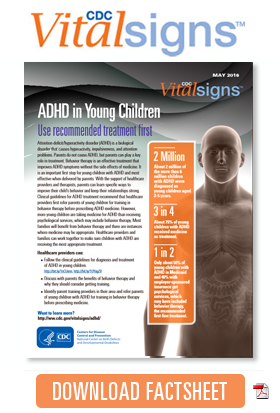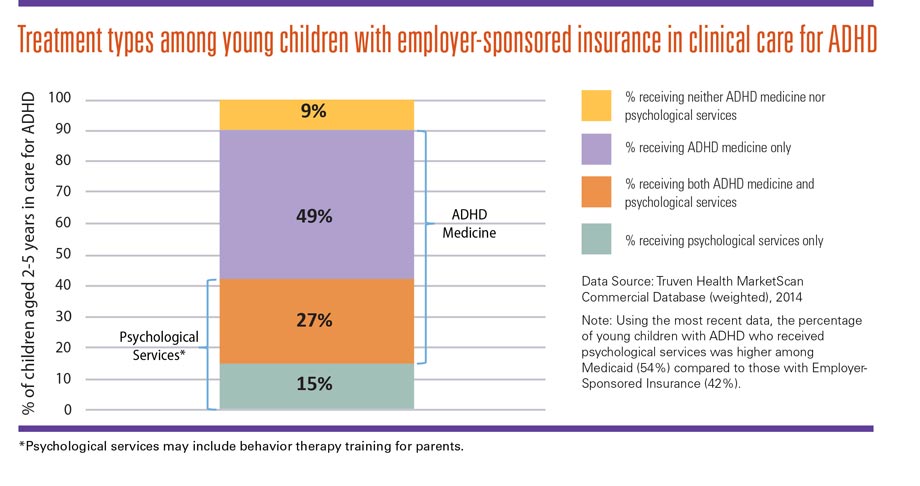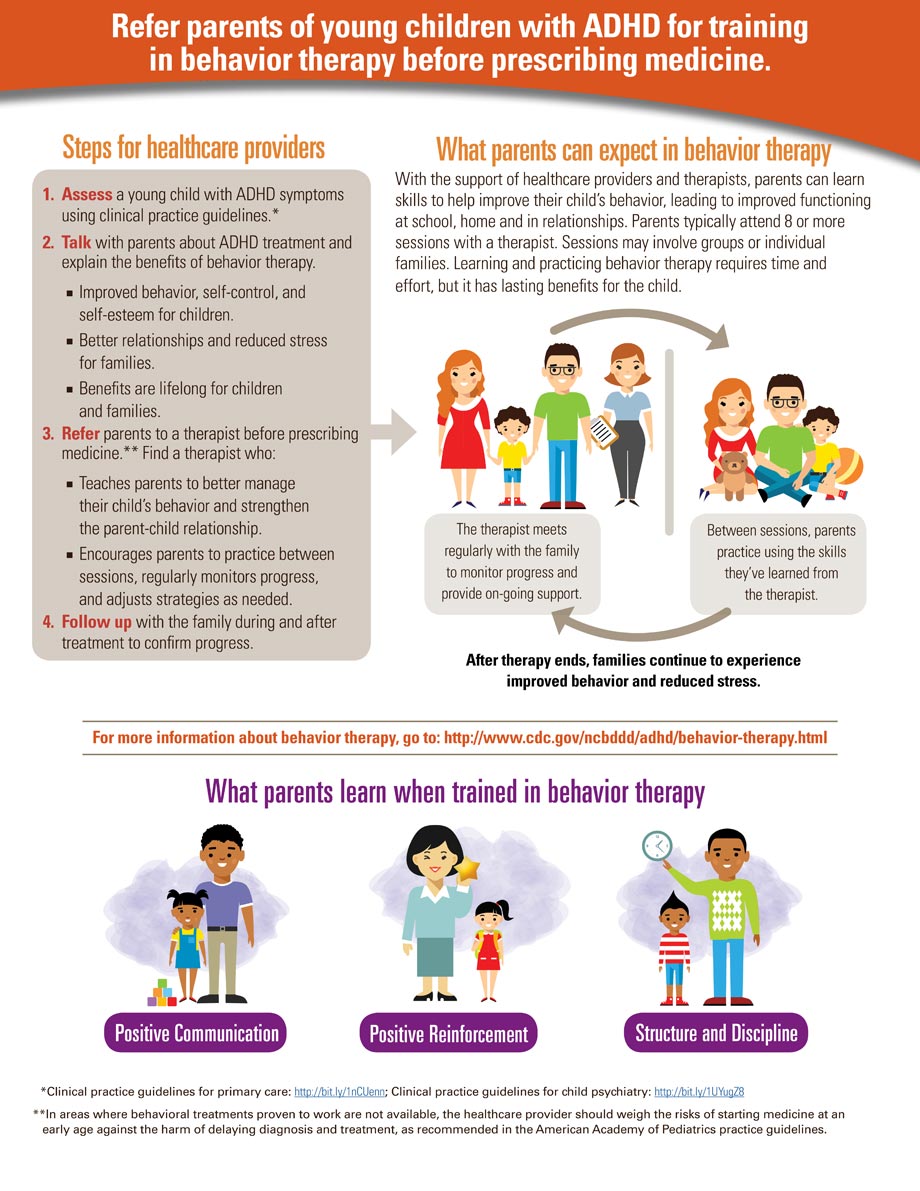Vital Signs: ADHD in Young Children
Use recommended treatment first
Attention-deficit/hyperactivity disorder (ADHD) is a biological disorder that causes hyperactivity, impulsiveness, and attention problems. Parents do not cause ADHD, but parents can play a key role in treatment. Behavior therapy is an effective treatment that improves ADHD symptoms without the side effects of medicine. It is an important first step for young children with ADHD and most effective when delivered by parents. With the support of healthcare providers and therapists, parents can learn specific ways to improve their child’s behavior and keep their relationships strong. Clinical guidelines for ADHD treatment recommend that healthcare providers first refer parents of young children for training in behavior therapy before prescribing ADHD medicine. However, more young children are taking medicine for ADHD than receiving psychological services, which may include behavior therapy. Most families will benefit from behavior therapy and there are instances where medicine may be appropriate. Healthcare providers and families can work together to make sure children with ADHD are receiving the most appropriate treatment.
Healthcare providers can:
- Follow the clinical guidelines for diagnosis and treatment of ADHD in young children.
http://bit.ly/1nCUenn, http://bit.ly/1UYugZ8 - Discuss with parents the benefits of behavior therapy and why they should consider getting training.
- Identify parent training providers in their area and refer parents of young children with ADHD for training in behavior therapy before prescribing medicine.

About 2 million of the more than 6 million children with ADHD were diagnosed as young children aged 2-5 years.
About 75% of young children with ADHD received medicine as treatment.
Only about 50% of young children with ADHD in Medicaid and 40% with employer-sponsored insurance got psychological services, which may have included behavior therapy, the recommended first-line treatment.
The recommended first treatment for young children with ADHD is underused.
- The American Academy of Pediatrics recommends healthcare providers first refer parents of young children with ADHD for training in behavior therapy before trying medicine.
- With the support of healthcare providers and therapists, parents can become trained in behavior therapy. Behavior therapy can work as well as medicine. Both behavior therapy and medicine work for about 70-80% of young children with ADHD.
- However, only about 40-50% of young children with ADHD received psychological services.* This percentage has not increased over time.
- ADHD medicine can cause side effects, such as poor appetite, stomach aches, irritability, sleep problems, and slowed growth. The long-term effects of ADHD medicine on young children are not known.
- Behavior therapy can take more time, effort, and resources than medicine and can be longer lasting.
Parents may need support in accessing behavior therapy in their area
- Healthcare providers and parents may not be aware of the recommendations for and benefits of behavior therapy for young children with ADHD.
- It may be difficult to find therapists who train parents in behavior therapy in some areas of the country. Visit this page for more help:
The Federal government is
- Offering coverage and Federal Medicaid reimbursement for recommended ADHD services that states seek to add to their Medicaid state plan.
- Helping states evaluate the impact of state-level programs to improve treatment for young children with ADHD.
- Evaluating new and existing state Medicaid and other insurance policies on their impact on treatment rates.
- Monitoring the number of children diagnosed with ADHD and the treatments they receive.
- Conducting research to better understand and treat ADHD.
- Sharing materials through the National Resource Center on ADHD.
http://www.help4adhd.org/NRC.aspx
Healthcare providers can
- Follow the clinical guidelines for diagnosis and treatment of ADHD in young children. http://bit.ly/1nCUenn, http://bit.ly/1UYugZ8
- Discuss with parents the benefits of behavior therapy and why they should consider getting training.
- Identify parent training providers in your area and refer parents of young children with ADHD for training in behavior therapy before prescribing medicine.
Parents can
- Talk with their child’s healthcare provider about the benefits of being trained in behavior therapy for their young child with ADHD.
- Learn and use these strategies to support their young child with ADHD.
Health professional organizations can
- Inform healthcare providers about the reasons for and benefits of parent training in behavior therapy.
- Train and support new and existing providers to deliver parent training in behavior therapy to fill service gaps.
- Include content about proven treatments for ADHD in graduate or professional curricula, training, and certification.
States can
- Encourage health plans and provider organizations to support reimbursement for behavior therapy services.
- Work to make sure that families have access to behavior therapy training.
- Evaluate ADHD medicine prescribing policies such as getting prior authorization and other policies that may affect ADHD treatment.
http://bit.ly/1SQQfN0 - Support scale up of proven parent training programs and other promising programs for children with ADHD.
Issue Details
- Vital Signs Issue details: ADHD in Young Children, Morbidity and Mortality Weekly Report (MMWR)
- Vital Signs – ADHD in Young Children [PODCAST – 1:15 minutes]
- Vital Signs – ADHD in Young Children [PSA – 0:60 seconds]
- CDC’s Attention-Deficit/Hyperactivity Disorder (ADHD) Website
- CDC’s Behavior Therapy for Young Children with ADHD: Finding a Therapist Website
- CDC’s ADHD: Treatment Website
- CDC’s ADHD: State Profiles—Medication Treatment and Behavior Therapy Website
- CDC’s ADHD: Recommendations Website
- MedlinePlus – Attention Deficit Hyperactivity Disorder
- American Academy of Child and Adolescent Psychiatry: Guideline on Psychopharmacological Treatment for Very Young Children
- CHADD: The National Resource on ADHD
Webinar Series Announcement
CDC and the National Council on Behavioral Health will host a webinar series for potential providers of behavior therapy, health care professionals, and parents in June to address behavior therapy for young children with ADHD. For more information on dates and times, visit the NCBH.
Providers of Behavior Therapy
A Clinician’s Tale: How do I Provide the Best Treatment for Young Children with disruptive behaviors, including ADHD?
Health Care Professionals
Get the 4-1-1: Everything Primary Care Providers (i.e., pediatricians, nurses, and physicians assistants) should know about parent training in behavior therapy while working with families with young children with ADHD.
Parents
I’m a parent of a young child with ADHD: why do I need training in behavior therapy?



